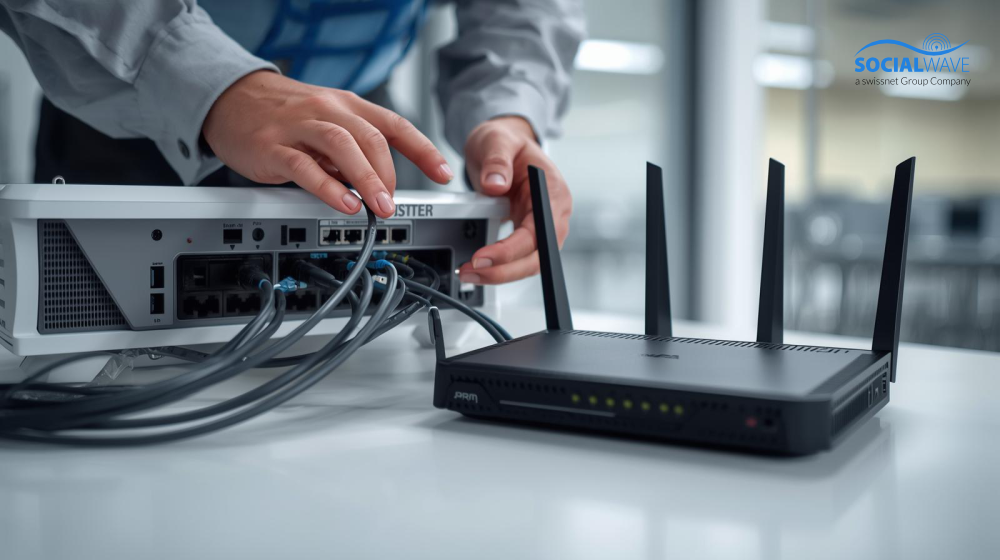WLAN - How does it actually work?

WLAN is a common term for all of us. But what is WLAN actually and how does it work? WLAN is the abbreviation for Wireless Local Area Network - in German: wireless local area network. It is derived from LAN (Local Area Network), which is the wired option. Nowadays, WiFi is essential for many people. It is used permanently not only privately, in one's own household, but also in public. The majority of public institutions such as train stations or libraries as well as restaurants, cafés, etc. offer public WLAN access - and that is also important, because surfing the Internet would only be half as convenient without WLAN. Simply put, a WLAN is a network with a wireless connection. This can either be used from mobile device to mobile device or, for example, via a router for direct Internet access. This is possible with any Internet-enabled device. The decisive factor is that, in contrast to the LAN, this takes place wirelessly via a radio signal, which, depending on the environment and strength, reaches a range of up to 50 meters.
The history of WiFi
The first WLAN standard (IEEE 802.11) dates back to the 1970s and had an output of around 2 Mbit back then. Compared to today, this is extremely low - we wouldn't even be able to watch a YouTube video with this performance. Even at that time, this WLAN standard was not useful for everyday use as we know it today. It was therefore only suitable for transmitting small amounts of data. In the following years, further WLAN standards were developed, which have continued to improve over time. Since the 1990s, the use of WLAN has also been common in private households. With improved performance and faster transmission, computers and laptops could initially be connected to the private network — without cables! Following successful establishment for private use, the WLAN standards were coordinated and adapted internationally. Since then, devices all over the world have been compatible with wireless networks. In the following years, WLAN continued to develop, up to the IEEE 802.11ac standard, which appeared in 2013. For some time, this was considered by far the fastest standard - with up to 400 times stronger performance than the first WLAN standard from 1977! This was overtaken in 2020 by the so-called Wi-Fi 6, which significantly improved both performance and speed.

The technology
The technical details behind a WLAN router and access to the Internet are very complex and extensive. We explain the basic structure and general process. A router, an Internet-enabled device and an Internet connection are generally required for use. The WLAN router is connected to a telephone or Internet connection and receives the Internet signal from it. In this way, the relevant data is fed to the router, which is then forwarded to the connected devices. The only requirement to be able to connect to the network is the presence of a so-called WLAN card. However, this is already included as standard in most devices. Within the network, it is possible to connect several mobile devices together, as well as direct access to the Internet. As soon as the radio signal has been activated, the router transmits permanently. Basically, any device in the vicinity can connect to the WLAN first. However, access is usually protected with a password, especially in private use. This WLAN key protects the network from unauthorized persons. As an alternative to a radio signal integrated in the router, WLAN access can also be used via a WLAN access point. A WLAN access point is a device that extends the WLAN or signal beyond the actual router. This is particularly suitable for public WLAN access, such as in restaurants. In this way, the signal can also be sent across several rooms. In addition, the connection is reinforced and the quality is improved. As already mentioned, mobile devices can connect to each other within a network, and on the other hand, the router can be used as a center, which enables direct Internet access. These operating modes are called “ad hoc network” or “infrastructure network.”
Ad-hoc network
In this mode, all devices are “equivalent”, meaning there is no need for a central office and therefore no access point. The devices in the network therefore communicate directly. However, it should be noted that only a limited number of participants is allowed in this mode.
Infrastructure network
In infrastructure mode, devices communicate within the network using an access point. This can be the router itself or a pure access point. This acts as the basis of the network, to which all “participants” log on and finally use access to the Internet.

When and where is WiFi useful?
In addition to wireless use, access is also provided for several devices in the same network. This is particularly advantageous in private households but also in offices, for example. In addition, a wireless network is more convenient than a wired one and, in most cases, less expensive. WLAN access is therefore also suitable for public use. Most restaurants, cafés, fashion houses, etc. now have a so-called WLAN hotspot, which gives customers access to the Internet. At first, this appears to be a simple service for customers and visitors — but these hotspots can do much more! In addition to convenience for the customer, this also gives the company the option of direct marketing.
WiFi marketing
The opportunities of a free WiFi hotspot are often underestimated. Especially since this offers an excellent opportunity to establish long-term customer loyalty, which not only increases sales but also increases the level of awareness of the company. In addition, valuable customer data, such as mobile phone numbers or e-mail addresses, is collected through the login. These in turn enable further marketing measures. In this area of marketing, Socialwave offers an automated tool that combines all advantages. You can find more information about guest and WiFi marketing here.

The benefits for the user
The key benefit is the wireless connection. This allows free movement within the signal range. In addition, many mobile devices today rely on a wireless network, as many no longer have a LAN cable connection. Smartphones and tablets are particularly affected. For users in public spaces, the cost factor also plays a role, as most WLAN access is free of charge. Access via LAN cable is also free of charge, but hardly feasible in public spaces. The user can thus reduce the consumption of their own mobile data and thus also the costs. The only disadvantage of WLAN is speed. Data and files are transferred much more slowly than with a LAN connection. However, this is not necessarily disruptive in private use or in public spaces. In the working world, however, laptops and computers are usually supported with LAN access in order to make data transmission faster and of even higher quality.
surety
If WiFi is used in private households, it is important to protect it from unauthorized persons. With sufficient encryption, strangers are denied access to their own network and, accordingly, to sensitive data. It is crucial that encryption and therefore the necessary authentication are active without interruption. As soon as these are deactivated, everyone in the area has unrestricted access to the WLAN. The currently most secure way to protect your own network is the WPA2 (WiFi Protected Access 2) standard. This only allows the user access when he authenticates himself using a password. Some security measures should also be observed with regard to WLAN use, especially in public hotspots. Here, too, the focus is on encrypting data. To ensure this, it is necessary to use a VPN, a so-called virtual private network. This is not only used for general data encryption, but also offers the option of surfing the Internet anonymously. This VPN tunnel replaces your own IP address with that of the network provider, which guarantees additional protection. For more information about safe browsing on public Wi-Fi, please here.

conclusion
Finally, it should be noted that WLAN in all its details is a highly complex topic that requires a great deal of knowledge. However, or precisely because of this, we have now summarized and explained the most important aspects for you. We are confronted with the Internet and therefore also with the use of networks on a daily basis - some of them already use them automatically. The Internet plays an essential role these days, which is not only reinforced by WLAN, but also supported much more. The wireless network is therefore also elementary for both private and business use. With our WLAN marketing package, your customers/patients/guests advertise for you, are happy and recommend you to others.








.svg)

.svg)
.svg)



